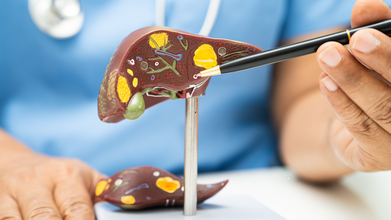- Health Conditions A-Z
- Health & Wellness
- Nutrition
- Fitness
- Health News
- Ayurveda
- Videos
- Medicine A-Z
- Parenting
Spotting vs Period vs Bleeding: How To Identify

Image Credits: Health and me
A woman's health is intricately linked to her menstrual cycle, which is an important sign of her overall well-being. Throughout puberty and menopause, hormonal changes affect not only fertility but also mood, energy, and long-term health. A normal cycle usually indicates balance, whereas abnormalities may suggest problems such as PCOS, endometriosis, or thyroid disease.
Our bodies do not always work in a perfect clockwork operation and unexpected vaginal bleeding can often confused us. Is it a mere spotting? A normal period? A symptom of something more concerning? Differences between spotting, menstrual bleeding, and intermenstrual bleeding should be understood is crucial for maintaining reproduction health.
Here is a short guide to help you differentiate while you are confused.
Spotting
Spotting is vaginal bleeding that doesn't happen as part of your regular menstrual period. It commonly manifests as fine droplets or smears of blood on clothing or toilet tissue. The intensity of the blood ranges from deep red (recent blood) to pink (having cervical mucus mixed in it) or brown (older, oxidized blood). Spotting is not very much and can't be seen in a way that needs either a tampon or a pad to absorb.
Common Causes of Spotting
Spotting is caused by numerous factors, and in the majority of instances, it is nothing to worry about. Some frequent causes are:
Hormonal Birth Control Transitions: New birth control technique, for instance, birth control pills, IUDs containing hormones, or implants, results in temporary spotting as the body adapts.
Ovulation Bleeding: A few individuals get spotting light around the time of ovulation as a result of hormonal changes. It normally happens in the mid-cycle and could be followed by slight cramping.
Cervical Ectropion: A harmless condition when cells from the inside of the cervical canal migrate to the outer cervix, causing the outer cervix to become more sensitive and prone to faint bleeding on coitus or physical activity.
Early Pregnancy (Implantation Bleeding): 15–25% of pregnant women experience light spotting around 10–14 days post-conception, which is confused with an early period.
When to See a Doctor
Spotting is usually harmless, but it's best to consult a doctor if:
- It continues after a few months of initiating new birth control
- Is accompanied by pelvic pain or abnormal discharge
- Occurs after frequent intercourse
- Occurs during pregnancy and is not verified as implantation bleeding
Menstrual Bleeding
There is a time, also known as a period or menstruation, when the uterine lining sheds due to changing hormone levels. It would last for approximately 2-7 days and is heavier initially. The hue and texture of period blood shift during the menstrual cycle:
Red: New active bleeding at the start of a period
Brown or dark red: Older, slower blood in leaving the uterus
Clots: It's normal to have small clots, but bigger clots may be a sign of heavy menstrual bleeding (HMB)
Why You Have a Period Essentially?
Menstruation is a part of the reproductive cycle, and it happens around every 21–35 days. When there's no pregnancy after ovulation, hormone levels fall, causing the uterine lining to be shed.
Signs Your Period May Be Abnormal
Though periods differ in different people, there are some signs that point towards probable underlying conditions:
- Prolonged bleeding (longer than 7 days)
- Heavy flow necessitating pad/tampon changes every 1–2 hours
- Severe cramps that disrupt daily life
- Irregular periods or absent periods
If you have any of these, conditions such as polycystic ovary syndrome (PCOS), endometriosis, or thyroid disease may be involved, and a medical visit is in order.
Intermenstrual Bleeding
Unlike spotting, intermenstrual bleeding is heavier and unexpected between regular periods. It may be from bright red to dark brown and can contain blood clots.
Possible Causes of Bleeding Between Periods
Sexually Transmitted Infections (STIs): Chlamydia and gonorrhea can lead to inflammation and abnormal bleeding.
Pelvic Inflammatory Disease (PID): A bacterial infection of the reproductive organs and can lead to abnormal bleeding.
Uterine Fibroids or Polyps: Benign growths in the uterus that may cause unexpected bleeding.
Endometrial Hyperplasia or Cancer: In some instances, abnormal bleeding may be a sign of abnormal cell growth in the lining of the uterus.
When to See a Doctor
See a doctor if intermenstrual bleeding is:
- Frequent or persistent
- Associated with pelvic pain or discomfort
- Associated with abnormal discharge, fever or painful sex
Recognizing your body's rhythms can assist you in identifying normal versus abnormal bleeding. Monitoring your menstrual cycle through an app or calendar may flag changes that should be checked with a doctor. If you have any questions regarding abnormal bleeding, visiting your health care provider is the way to go.
Flu Shot: Will Getting Vaccinated Twice This Year Boost Immunity?

Credits: Canva
As flu season approaches, many people wonder whether getting vaccinated twice in the same year might offer extra protection. With immunity known to fade and flu viruses changing fast, the question sounds reasonable. But according to public health experts, doubling up on flu shots rarely delivers added benefit for adults.
Flu Shot: Why a Second Flu Shot Usually Does Not Help
There is no known harm in receiving two flu shots in one year, but research shows it is largely unnecessary. Katrine Wallace, an epidemiologist at the University of Illinois at Chicago, explains that most adult immune systems have already been exposed to both the influenza virus and the vaccine over the years.
Because of this prior exposure, studies have not found improved protection from a second flu shot, even among older adults whose immune responses may be weaker. For the majority of people, one influenza vaccination per year is sufficient to reduce the risk of severe illness and complications.
The guidance is different for children. The US Centers for Disease Control and Prevention recommends that children under the age of nine who have never received a flu vaccine should get two doses during their first vaccination season to build adequate immunity.
Flu Shot: Why You Still Need a Flu Shot Every Year?
While a second shot in the same season does not add much value, annual vaccination remains important. Flu viruses mutate quickly, far faster than viruses like Covid. This means last year’s vaccine is less effective against the strains circulating this season.
In addition, immunity from the flu shot gradually declines over time. These two factors make yearly vaccination necessary, even for people who rarely fall sick.
Flu Shot: Which Flu Vaccine Should Children Get?
As per CDC, there are two kinds of influenza vaccines in use. One is the injectable vaccine commonly known as the flu shot. The other is given as a nasal spray.
This year, all flu vaccines approved for children are designed to protect against three strains of the virus, including two influenza A strains and one influenza B strain. During any flu season, several types of flu viruses can circulate at the same time, and in some cases, these viruses may shift or evolve as the season progresses.
Flu Shot: Timing Matters More Than Taking Two Shots
Experts also stress that when you get the flu shot matters almost as much as getting it at all. Wallace notes that vaccination in August or early September is generally not advised for most adults, since protection may weaken before flu activity peaks.
There are exceptions. Pregnant people in their third trimester may be advised to get vaccinated earlier to pass antibodies to their baby, who cannot receive a flu shot immediately after birth, as per the CDC.
For most adults, the best approach is simple: get one flu shot per year and get it at the right time. There is no need to worry about doubling doses unless advised by a doctor. One well-timed vaccination remains the most effective and evidence-backed strategy
Nebokitug Explained: Antibody Used To Treat A Rare Liver Disease

Credits: Canva
For people living with primary sclerosing cholangitis or PSC, medical options have always been painfully limited. Until now, there has been no approved drug that can slow the disease itself. Treatment has mostly meant managing symptoms and waiting, often for years, until a liver transplant becomes the only option. That is why new results around a monoclonal antibody called nebokitug are being seen as a turning point.
Researchers from the University of California Davis have reported promising findings from a Phase 2 clinical trial showing that nebokitug appears safe and may actually reduce liver inflammation and scarring. The study was published in the American Journal of Gastroenterology and has brought cautious optimism to both doctors and patients.
What Exactly Is PSC?
PSC is a rare, long-term liver disease that mainly affects the bile ducts. These ducts act like tiny pipelines that carry bile from the liver to the small intestine, where it helps digest fats. In PSC, these ducts become inflamed, damaged, and scarred over time. As they narrow, bile starts backing up in the liver, slowly causing liver injury.
Many people with PSC also have inflammatory bowel disease, especially ulcerative colitis. This strong link has led researchers to believe that ongoing gut inflammation may trigger immune reactions that damage the liver as well. Symptoms can range from extreme tiredness and itching to yellowing of the skin and eyes. Some patients have no symptoms at all in the early stages, which makes the disease harder to catch.
Why Treatment Has Been So Difficult
One of the biggest challenges with PSC is that doctors have not had a way to stop the scarring process itself. Once fibrosis sets in, it slowly progresses and increases the risk of liver failure and bile duct cancer. While medications can help with itching or infections, they do not change the course of the disease. This gap in treatment is what makes the nebokitug study so important.
How Nebokitug Works
Nebokitug is a lab-made antibody designed to block a protein called CCL24. This protein plays a key role in driving inflammation and fibrosis in the liver. In people with PSC, CCL24 levels are higher than normal and are found around the bile ducts where damage is most severe.
By blocking CCL24, nebokitug aims to calm the immune response and slow down the scarring process. Earlier lab and animal studies suggested this approach could work. The new trial is one of the first to test this idea in people with PSC.
What the Trial Found
The Phase 2 study included 76 patients from five countries. Participants received either one of two doses of nebokitug or a placebo through an IV every three weeks for 15 weeks. The main goal was to check safety, since this was still an early-stage trial.
The results were encouraging. Nebokitug was found to be safe and well tolerated. More importantly, patients who already had more advanced liver scarring showed improvements in liver stiffness and markers linked to fibrosis when compared to those on placebo. These changes suggest that the drug may be doing more than just easing symptoms.
Experts involved in the study say these findings could change the future of PSC care. Reducing inflammation and fibrosis could slow disease progression and delay or even prevent the need for a transplant in some patients. While larger trials are still needed, nebokitug represents one of the strongest signals yet that PSC may finally have a disease-modifying treatment on the horizon.
Can Drinking Beer Cause Cancer? A New Study Says There Is No Safe Limits

Credits: Canva
Now, drinking beer too could increase the risk of mouth cancer. On Tuesday, researchers at the Tata Memorial Centre (TMC) reported this adding new evidence. They found a 59 per cent higher risk of mouth cancer in people who drank, on average, just two grams of alcohol from beer daily, compared with those who did not drink. The research suggests that there may not be any safe limit to drink.
What Did The Study Reveal About Beer And Cancer?
Their study in India's large scale analysis that probs link between alcohol and cancer of the buccal mucosa. This is the pink lining of cheeks and lips. In India, this kind of cancer is the second most common malignancy in India after breast cancer. It also leads to 1,40,000 new cases and nearly 80,000 deaths each year.
Who Are More Prone To Buccal Mucosa Cancer?
People who consume more than one glass of alcohol a day and chew tobacco on a day to day basis are five times more at risk of developing this cancer as compared to those who do not drink or chew tobacco.
The findings of the study was published in the journal BMJ Global Health and it suggests that joint use of both, alcohol and tobacco leads to 62 per cent of all buccal mucosa cancer in the country.
As Telegraph reported, Tata Memorial Centre for Cancer Epidemiology unit's head of molecular epidemiology and population genomics unit Sharayu Mhatre said, "We see an unmistakable pattern: the more alcohol people drink, the greater their risk of buccal mucosal cancer."
Buccal mucosal cancer continues to pose a serious public health challenge in India. Among 100 patients diagnosed with locally advanced stages of the disease, 57 die within five years, a mortality rate that experts say highlights the urgent need for prevention, early detection, and stronger regulation of risk factors.
Alcohol Emerges as a Major Risk Factor
While the link between alcohol and cancer is well known, new findings reinforce just how dangerous alcohol consumption can be for oral health. Researchers found that people who consumed alcohol had a 68% higher risk of developing buccal mucosal cancer compared to non-drinkers.
What stood out most was the type of alcohol consumed. Unregulated, locally brewed liquor carried the highest risk, increasing cancer likelihood by 87%, compared to 72% among consumers of regulated, commercially sold drinks. Experts point out that these local brews often contain significantly higher ethanol concentrations and lack quality control.
Not Just Heavy Drinking—Even Small Amounts Matter
The study analyzed drinking patterns among over 3,700 participants, comparing cancer patients with healthy individuals. Alcohol types ranged from beer and spirits like whisky and vodka to traditional local drinks such as bangla and tharra. Ethanol levels varied widely—from 5% in beer to as high as 90% in some locally distilled spirits.
Alarmingly, increased cancer risk was seen even at low levels of alcohol intake. As little as two grams of alcohol a day from beer, or roughly one glass of stronger liquor, was enough to raise concern.
Alcohol and Tobacco: A Dangerous Combination
The risk escalates dramatically when alcohol use is combined with tobacco chewing. Tobacco alone raised cancer risk by 200%, alcohol alone by 76%, but together, the risk shot up to 346%. Researchers explain that alcohol may damage the mouth’s protective lining, making it easier for tobacco-related carcinogens to penetrate and cause harm.
Health experts stress that these findings underline the need for greater public awareness, stricter monitoring of locally brewed alcohol, and stronger prevention strategies. The World Health Organization has already warned that no level of alcohol is safe, noting that even light or moderate drinking contributes to a significant number of alcohol-related cancers globally.
For India, where oral cancers remain widespread, these insights serve as a critical reminder: everyday habits can have life-altering consequences.
© 2024 Bennett, Coleman & Company Limited

